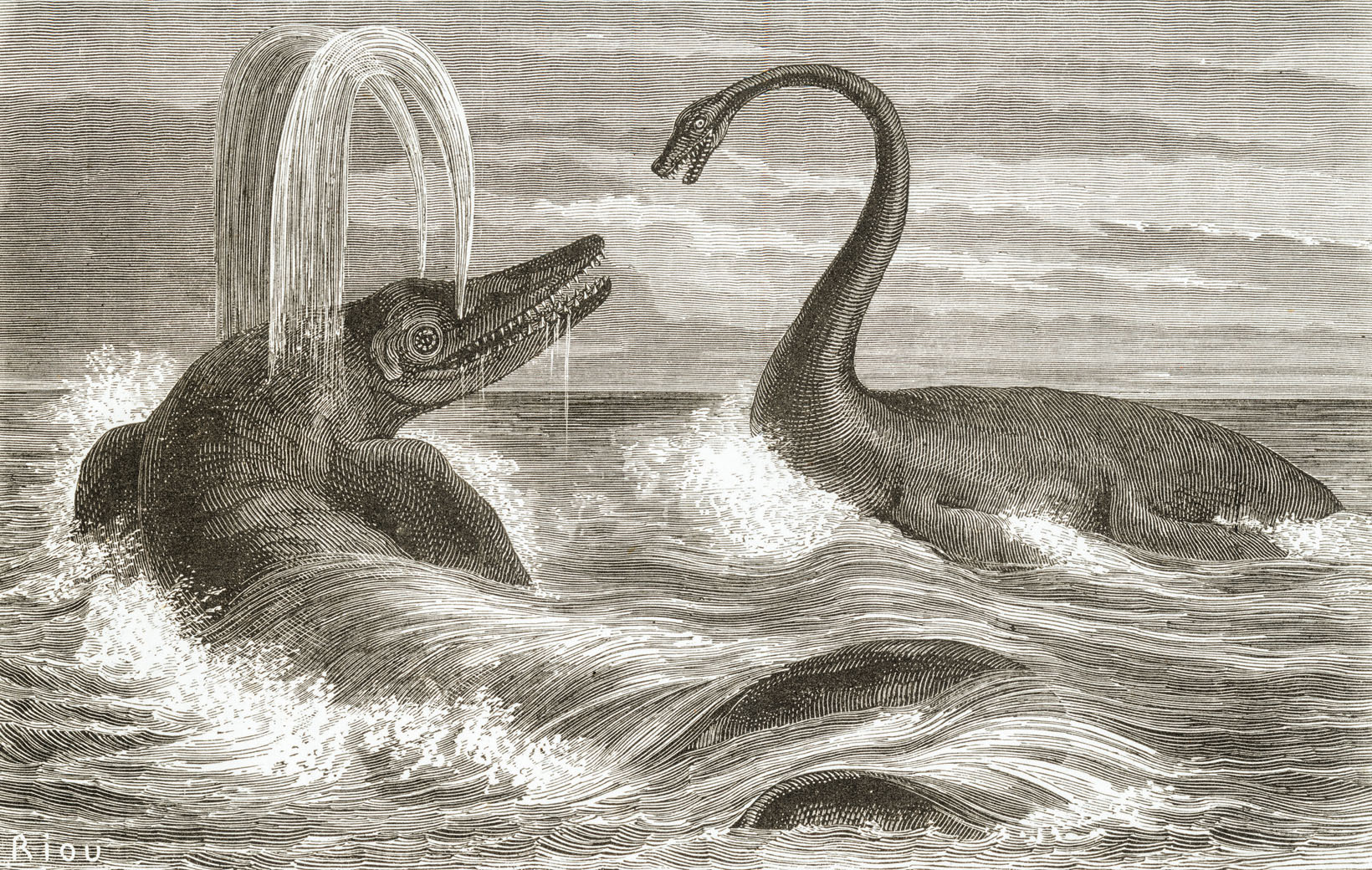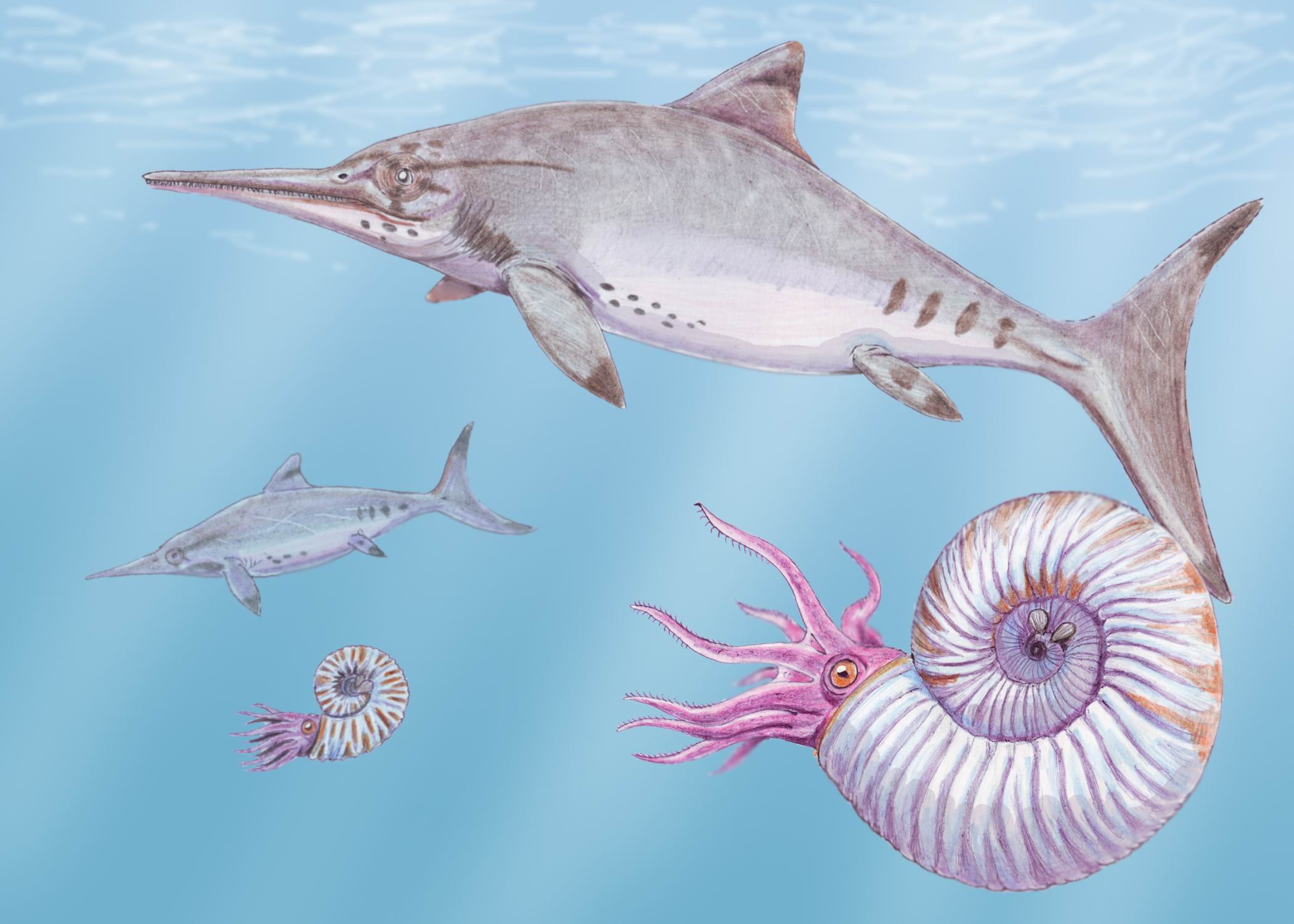|
Ophthalmosaurus
''Ophthalmosaurus'' (meaning "eye lizard" in Greek) is an ichthyosaur of the Jurassic period (165–150 million years ago). Possible remains from the Cretaceous, around 145 million years ago, are also known. It was a relatively medium-sized ichthyosaur, measuring long and weighing . Named for its extremely large eyes, it had a jaw containing many small but robust teeth. Major fossil finds of this genus have been recorded in Europe with a second species possibly being found in North America. Description ''Ophthalmosaurus'' was a medium-sized ichthyosaur, measuring long and weighing . It had a robust, streamlined body that was nearly as wide as it was tall in frontal view. Like other derived ichthyosaurs ''Ophthalmosaurus'' had a powerful tail ending in a pronounced bi-lobed caudal fluke whose lower half was formed around the caudal spine whereas the upper lobe was made up entirely from soft tissue. The limbs of ''Ophthalmosaurus'' were short and rounded with the forelimbs bein ... [...More Info...] [...Related Items...] OR: [Wikipedia] [Google] [Baidu] |
Acamptonectes
''Acamptonectes'' is a genus of ophthalmosaurid ichthyosaurs, a type of dolphin-like marine reptiles, that lived during the Early Cretaceous around 130 million years ago. The first specimen, a partial adult skeleton, was discovered in Speeton, England, in 1958, but was not formally described until 2012 by Valentin Fischer and colleagues. They also recognised a partial subadult skeleton belonging to the genus from Cremlingen, Germany, and specimens from other localities in England. The genus contains the single species ''Acamptonectes densus''; the generic name means "rigid swimmer" and the specific name means "compact" or "tightly packed". The generic name refers to unusual adaptations in the body of ''Acamptonectes'' that made its trunk rigid, including tightly fitting bones in the occiput (back and lower part of the skull) and interlocking vertebral centra ("bodies" of the vertebrae), which were likely adaptations that enabled it to swim at high speeds with a tuna-like f ... [...More Info...] [...Related Items...] OR: [Wikipedia] [Google] [Baidu] |
Arthropterygius
''Arthropterygius'' is a widespread genus of ophthalmosaurid ichthyosaur which existed in Canada, Norway, Russia, and Argentina from the late Jurassic period and possibly to the earliest Cretaceous. Description ''Arthropterygius'' appears to have been a relatively large ichthyosaur, with all species measuring between long. The partially preserved specimen PMO 222.655 has been estimated at based on comparisons to the contemporary ophthalmosaurid '' Undorosaurus''. This specimen was probably mature or close to maturity at time of death, judging by the convex head of the humerus and the smooth texture of the humeral shaft. Skull and axial skeleton The skull of ''Arthropterygius'' has become well known due to the discovery of a well preserved skull from Svalbard. It is unusual among ichthyosaurs in having a very short, yet also robust rostrum for its skull length. As a result, the orbit appears very large (about 0.34× the skull length). The skull bears a very large pineal for ... [...More Info...] [...Related Items...] OR: [Wikipedia] [Google] [Baidu] |
Ophthalmosauridae
Ophthalmosauridae is an extinct family of thunnosaur ichthyosaurs from the Middle Jurassic to the early Late Cretaceous (Bajocian - Cenomanian) worldwide. Almost all ichthyosaurs from the Middle Jurassic onwards belong to the family, until the extinction of ichthyosaurs in the early Late Cretaceous. Opthalmosaurids appeared worldwide during early Bajocian, subsequent to the disappearance of most other ichthyosaur lineages after the end of the Toarcian. Currently, the oldest known ophthalmosaurids is '' Mollesaurus'' from the early Bajocian of Argentina, as well as indeterminate remains of the same age from Luxembourg and Canada. Named by George H. Baur, in 1887, the family contains the basal taxa like '' Ophthalmosaurus''. Appleby (1956) named the taxon Ophthalmosauria which was followed by some authors, but these two names are often treated as synonyms; Ophthalmosauridae has the priority over Ophthalmosauria. However, some researchers argue that Ophthalmosauridae should be restri ... [...More Info...] [...Related Items...] OR: [Wikipedia] [Google] [Baidu] |
Ichthyosaur
Ichthyosaurs (Ancient Greek for "fish lizard" – and ) are large extinct marine reptiles. Ichthyosaurs belong to the order known as Ichthyosauria or Ichthyopterygia ('fish flippers' – a designation introduced by Sir Richard Owen in 1842, although the term is now used more for the parent clade of the Ichthyosauria). Ichthyosaurs thrived during much of the Mesozoic era; based on fossil evidence, they first appeared around 250 million years ago ( Ma) and at least one species survived until about 90 million years ago, into the Late Cretaceous. During the Early Triassic epoch, ichthyosaurs and other ichthyosauromorphs evolved from a group of unidentified land reptiles that returned to the sea, in a development similar to how the mammalian land-dwelling ancestors of modern-day dolphins and whales returned to the sea millions of years later, which they gradually came to resemble in a case of convergent evolution. Ichthyosaurs were particularly abundant in the Late Triassic ... [...More Info...] [...Related Items...] OR: [Wikipedia] [Google] [Baidu] |
Undorosaurus
''Undorosaurus'' is an extinct genus of ophthalmosaurid ichthyosaur known from western Russia, Svalbard, and Poland. It was a large ichthyosaur, with the type species measuring long and weighing . Discovery and naming ''Undorosaurus'' was named by Vladimir M. Efimov in 1999 and the type species is ''Undorosaurus gorodischensis''. The specific name is named after Gorodische, the type locality of this taxon. ''U. trautscholdi'' is named in honor of the geologist H. Trautschold who collected and made the first description of the fossils of the holotype of the species. ''Undorosaurus'' was first known from the holotype UPM EP-II-20 (527), a partial three-dimensionally preserved skeleton which preserved partial skull. It was collected near the Volga river at Gorodische from the ''Epivirgatites nikitini'' ammonoid zone, dating to the Late Jurassic. A second species, ''U. trautscholdi'' was described by M.S. Arkhangelsky and N.G. Zverkov in 2014 from a partial left fore ... [...More Info...] [...Related Items...] OR: [Wikipedia] [Google] [Baidu] |
Mollesaurus
''Mollesaurus'' is an extinct genus of large ophthalmosaurine ophthalmosaurid ichthyosaur known from northwestern Patagonia of Argentina. Etymology ''Mollesaurus'' was named by Marta S. Fernández in 1999 and the type species is ''Mollesaurus periallus''. The generic name is derived from the name of the Los Molles Formation, where the holotype was collected, and ''sauros'', Greek for "lizard". The specific name is derived from ''periallos'', Greek for "before all others", in reference to the fact that it is the oldest ophthalmosaurid and one of the oldest thunnosaurs. History of study ''Mollesaurus'' is known from the holotype MOZ 2282 V, articulated partial skeleton which preserved partial skull and most of the vertebral column. It was collected in the Chacaico Sur locality from the ''Emileia giebeli'' ammonoid zone of the Los Molles Formation, Cuyo Group, dating to the early Bajocian stage of the Middle Jurassic, about 171.6-170 million years ago. ''Mollesau ... [...More Info...] [...Related Items...] OR: [Wikipedia] [Google] [Baidu] |
Baptanodon
''Baptanodon'' is an ichthyosaur of the Late Jurassic period (160-156 million years ago), named for its supposed lack of teeth (although teeth of this genus have since been discovered). It had a graceful long dolphin-shaped body, and its jaws were well adapted for catching squid. Major fossil finds of this genus have been recorded in North America. The type species, ''Sauranodon natans'', was originally included under ''Sauranodon'' in 1879,O. C. Marsh. 1879. A new order of extinct reptiles (Sauranodonta), from the Jurassic Formation of the Rocky Mountains. ''The American Journal of Science and Arts, series 3'' but this name was preoccupied. Discovery and species ''Baptanodon'' is a replacement name for ''Sauranodon'' applied to ichthyosaur material in 1879 and was moved to its own genus ''Baptanodon'' in 1880 when ''Sauranodon'' was found to be preoccupied. ''Baptanodon'' was considered a junior synonym of ''Ophthalmosaurus'' by Maisch & Matzke (2000).Maisch MW, Matzke AT. 200 ... [...More Info...] [...Related Items...] OR: [Wikipedia] [Google] [Baidu] |
Nannopterygius
''Nannopterygius'' (meaning "small wing/flipper" in Greek) is an extinct genus of ophthalmosaurid ichthyosaur that lived during the Middle Jurassic to the Early Cretaceous (Callovian to Berriasian stages). Fossils are known from England, Kazakhstan, Russia, and NorwayMcGowan, C. & Motani, R. (2003). ''Ichthyopterygia''. ''In'' Sues, H.-D. Handbook of Paleoherpetology, vol. 8. Verlag Dr. Friedrich Pfeil, Munich, 175 pp., 19pls. and six species are currently assigned to the genus. Description ''Nannopterygius'' was small for an ichthyosaur, measuring up to long at maximum. About of this was tail, including a deeply forked and probably homocercal caudal fin. The head is long, with a typical long narrow rostrum. The eyes are large, hence its classification as an ophthalmosaurid, and have a bony sclerotic ring inside the eye socket. There are at least 60 disc-shaped vertebrae, although owing to the condition of the fossil it is not possible to tell exactly how many there were, ... [...More Info...] [...Related Items...] OR: [Wikipedia] [Google] [Baidu] |
Yasykovia
''Nannopterygius'' (meaning "small wing/flipper" in Greek) is an extinct genus of ophthalmosaurid ichthyosaur that lived during the Middle Jurassic to the Early Cretaceous (Callovian to Berriasian stages). Fossils are known from England, Kazakhstan, Russia, and NorwayMcGowan, C. & Motani, R. (2003). ''Ichthyopterygia''. ''In'' Sues, H.-D. Handbook of Paleoherpetology, vol. 8. Verlag Dr. Friedrich Pfeil, Munich, 175 pp., 19pls. and six species are currently assigned to the genus. Description ''Nannopterygius'' was small for an ichthyosaur, measuring up to long at maximum. About of this was tail, including a deeply forked and probably homocercal caudal fin. The head is long, with a typical long narrow rostrum. The eyes are large, hence its classification as an ophthalmosaurid, and have a bony sclerotic ring inside the eye socket. There are at least 60 disc-shaped vertebrae, although owing to the condition of the fossil it is not possible to tell exactly how many there were, show ... [...More Info...] [...Related Items...] OR: [Wikipedia] [Google] [Baidu] |



